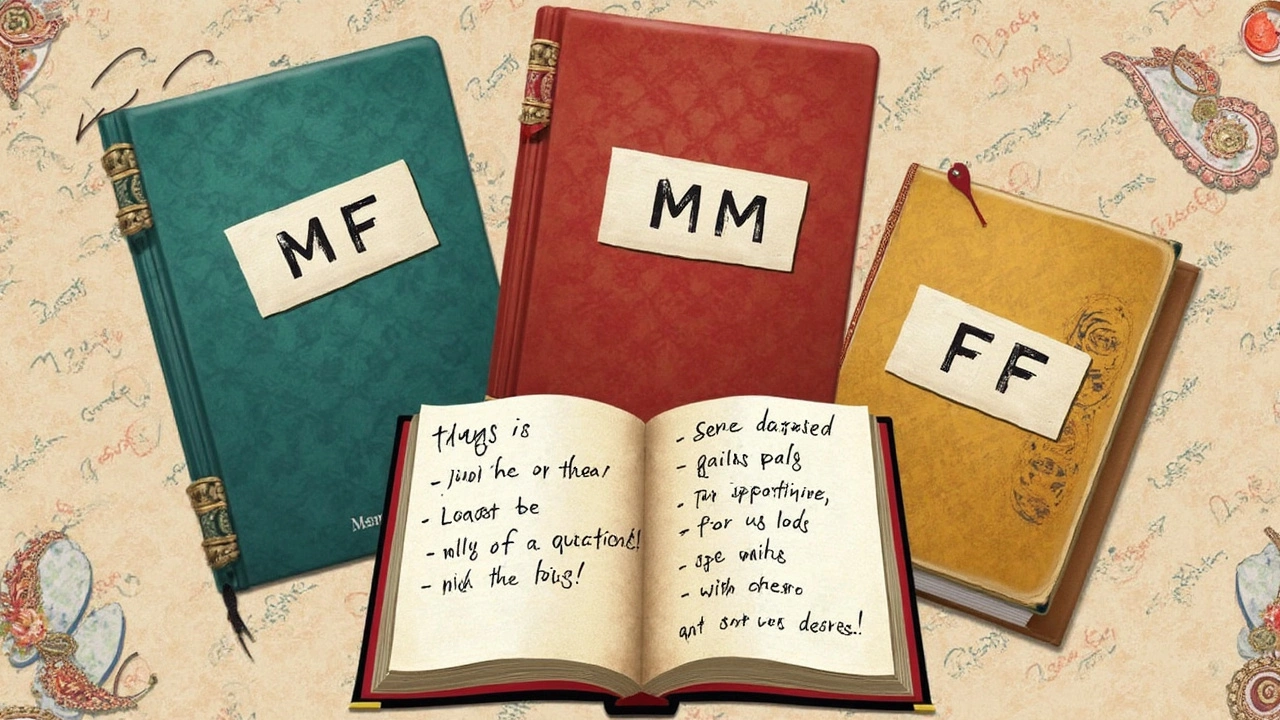Seen 'MF' stamped on a romance book and wondered if it’s code for something spicy? It’s not as mysterious as it looks. 'MF' stands for 'male/female'—as in, the romance is between a man and a woman. This label isn’t about the plot or heat level; it’s just the genders of the two main love interests. Sounds simple, but if you’re picking your next steamy read, this tiny acronym saves you a lot of guessing.
Why slap a label on it at all? Short answer: online book shopping isn’t like wandering dusty aisles anymore. With every relationship combo under the sun, authors and publishers need a quick way to tell you what’s inside. 'MF' stops you from accidentally picking up a menage, a same-gender romance, or something entirely different from your mood.
- The Meaning of MF in Romance
- Why Authors and Publishers Use It
- How MF Differs from Other Labels
- Spotting Genuine MF Romance vs. Mislabeling
- Tips for Finding Your Preferred Romance Genre
The Meaning of MF in Romance
If you've seen the term MF next to a romance novel title, it’s not some secret club lingo—it's just short for male/female. In romance publishing, 'MF' makes it clear that the main romantic couple is made up of one man and one woman. There’s nothing fancy or hidden in the label. It just tells you straight-up who’s falling in love and who’ll likely get that happy ending.
This label has nothing to do with what kind of story it is—whether you’re looking at historical, fantasy, or even contemporary romance. It’s all about the central relationship. Here’s what sets it apart: MF is about the romantic focus, not the friendship group, side plots, or anything else going on in the book. It lets you know there’s a singular, male/female romantic arc front and center.
Labels like MF started showing up more often as online bookstores and ebook platforms took off in the late 2000s. Suddenly, readers needed a shortcut to tell the difference between MF, MM (male/male), FF (female/female), and a slew of other relationship types. Turns out, this tiny abbreviation helps both readers and authors find each other in the chaos of search results.
Just to clear things up, here's a quick comparison of the most common romance relationship labels you’ll spot online:
| Label | Relationship Focus |
|---|---|
| MF | Male/Female |
| MM | Male/Male |
| FF | Female/Female |
| MMM | Male/Male/Male |
| Menage/Reverse Harem | More than two, often with mixed genders |
So, when you see MF on a book listing, it’s just the publisher or author making life easier—no reading between the lines required. If you want a straightforward, man-woman romance, you know you’re in the right place.
Why Authors and Publishers Use It
Ever tried to skim the romance section and felt lost in a jungle of labels? You're not alone. These days, romance novels come in a massive range of styles and relationship combos. That’s exactly why authors and publishers use clear tags like MF. It lets you spot the relationship type—male/female—at a glance, without digging through blurbs or reviews.
Shopping for romance books has changed a lot. A few years ago, you went to a store and picked up whatever looked good on the shelf. Now, with eBooks and endless online options, readers expect precise labels, so they don't waste time or money on a story that’s not their thing. Authors want happy readers, not folks who accidentally buy a book with the wrong pairing.
The big online stores, like Amazon or Kobo, have even made category labels a must for self-published authors. A book with an MF tag ends up in front of the right crowd, not drowning in the wrong pool. And if someone’s looking for LGBT, menage, or other styles, those labels steer readers where they want to go, too.
- Readers trust the tags to find what they enjoy.
- Writers use them to avoid bad reviews from readers who expected something else.
- Bookstores and online retailers require accurate categorization for targeted suggestions.
Want proof? Check out how romance sub-genre labeling exploded around 2013, the same year that self-publishing and eBook sales shot up. Publishers and indie authors had to get crystal-clear about content, or risk huge return rates and angry customers.
| Year | Estimated Romance Titles Published | Rise of Sub-Genre Labels |
|---|---|---|
| 2010 | 9,400 | Moderate |
| 2013 | 20,800 | High |
| 2021 | 48,700 | Standard |
Bottom line: without these tags, romance readers have to gamble on every new book. Clear labels like MF take out the guesswork and make sure each story finds the right reader.

How MF Differs from Other Labels
Let’s get real: romance books use all sorts of short labels, and they don’t all mean the same thing. Knowing the differences can save you from picking up a book you’re not in the mood for—or missing out on something you’d love.
MF labels are straight to the point: the main romance is only between a guy and a girl. No love triangles, no three-way stuff, just a one-on-one connection. But what about the other codes you see?
- MM means the story is all about two men falling for each other.
- FF signals a romance between two women.
- MMM, MMF, and FMM indicate group or ménage pairings—those letters show how many and which genders are at play. For example, MMF is two men, one woman in a romantic relationship, usually all together.
- Reverse Harem (RH) means one heroine with several male love interests—think one leading lady, lots of guys, and most of the time, everybody’s involved.
- Poly or Polyamory points to consensual relationships that include more than two partners, with varying gender combos.
Here’s a quick chart to clear up common acronyms you’ll see when you browse romance books:
| Label | Main Relationship | Example |
|---|---|---|
| MF | Male/Female | One man, one woman |
| MM | Male/Male | One man, one man |
| FF | Female/Female | One woman, one woman |
| MMF | Male/Male/Female | Two men, one woman |
| FMM | Female/Male/Male | One woman, two men |
| RH | Reverse Harem | One woman, several men |
| Poly | Polyamory (multiple partners) | Varies |
So next time you see these codes, you’ll know exactly what to expect and won’t get blindsided by surprise relationship combos. That label up front? It’s a promise about the kind of romance you’ll get—no funny surprises halfway through the book.
Spotting Genuine MF Romance vs. Mislabeling
Ever picked up a book labeled MF only to find out it’s not what you signed up for? Mislabeling happens more often than you think, especially now that indie publishing and self-publishing are so huge. Sometimes, a book gets tagged MF because there’s a guy and a girl, but the main romance isn’t actually between them, or one of them isn’t the central figure in the romance at all.
What does real MF romance look like? You get a main relationship dynamic—male and female—that drives the story. Both leads are equally important to the plot, and the romance between them is front and center, not stuck on the sidelines or hijacked by another couple. When browsing, descriptions and actual content should match that expectation.
Mislabeling usually goes two ways:
- The book has lots of relationship drama, but the main romance isn’t MF, or it shares the spotlight with other couples (like in menage or poly stories).
- The male or female lead barely gets page time, or the romance wraps up too fast because other storylines take over.
This kind of mix-up isn’t rare. In surveys run by romance reader groups in 2024, over 30% of readers said they’ve gotten a mislabeled romance in the last year. Check out some stats below:
| Year | % of Readers Reporting Mislabeling | Top Source |
|---|---|---|
| 2022 | 24% | Self-published novels |
| 2023 | 28% | Online book platforms |
| 2024 | 33% | Self-published/Indie books |
Want to avoid buying a book labeled MF that’s not? Read the blurb carefully. If the story hints at more than two love interests or swaps who the main couple is, that’s a flag. Also, check reviews—some reviewers are quick to call out sketchy labeling. Sites like Goodreads often have “shelf” tags from readers that spill the truth. If you can, read the sample or free first chapter online to double-check if the book fits your preferred type before you invest your time or money.

Tips for Finding Your Preferred Romance Genre
The world of romance books is packed with labels and genres, making it both exciting and a bit overwhelming. Want to cut through the clutter and land exactly where you’ll be happiest as a reader? Check out these practical tips, and you’ll never waste time on the wrong story again.
- MF stands for male/female relationships. If you want classic romance between a man and a woman, this is what to search for on book retailer sites or library apps.
- Look for mention of other labels—like MM (male/male), FF (female/female), or Menage (romance involving three or more people)—if you want more variety than traditional pairings.
- If you’re curious about the heat level (how much steam, how explicit), pay attention to terms like "sweet" (no sex), "closed door" (fade to black), or "erotic" (extra spicy scenes). These are often listed after the relationship labels.
- Check the book’s description or Goodreads page for both relationship labels and content warnings. Authors often pile all the important stuff near the top to save you time.
- If you like a certain trope—friends to lovers, enemies to lovers, fake dating—use those phrases in your searches along with "MF" or whatever label you want. This combo gets you the exact vibe you’re after.
Let’s break down some of the most common romance acronyms and what they mean, all in one easy chart:
| Label | What It Means |
|---|---|
| MF | Male/Female pairing |
| MM | Male/Male pairing |
| FF | Female/Female pairing |
| Menage | Three or more partners in a romantic/sexual relationship |
| RH (Reverse Harem) | One woman, multiple men, all romantically involved |
| MFN | Male/Female/Nonbinary pairing (or triad) |
Don’t forget: Just because a book is labeled a certain way doesn’t guarantee the representation is deep or realistic. It’s always a good move to skim reviews or readers’ comments before jumping in, especially if you’re looking for something specific in how relationships are handled.
Want to really drill down? Most online retailers and review sites let you filter or search by genre, pairing, heat level, and even precise tropes. It can feel like playing detective at first, but after a few searches you’ll get a feel for the right combinations to find your perfect read. Happy hunting!

